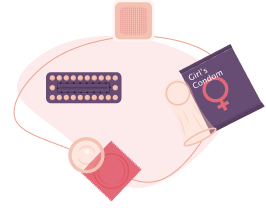
Fertility Awareness Methods
“Fertility awareness” methods are a method of contraception where a woman tracks and knows how to tell when the fertile time of her monthly cycle starts and ends. This is also sometimes called periodic abstinence or natural family planning. A woman can use several ways, alone or in combination, to tell when her fertile time begins and endsCalendar-based methods
- Calendar-based methods are where a woman keeps track of days of the menstrual cycle to identify the start and end of the fertile time.
- One example is the Standard Days Method, where a woman avoids unprotected sexual intercourse on days 8 through 19 of the menstrual cycle.
- Another example is the calendar rhythm method.
Symptoms-based methods
- Symptoms-based methods depend on tracking an observing signs of fertility in a woman’s body, for example:-Cervical secretions: When a woman sees or feels cervical secretions, she may be fertile. She may feel just a little vaginal wetness. -Basal body temperature (BBT): A woman’s resting body temperature goes up slightly after the release of an egg (ovulation). She is not likely to become pregnant from 3 days after this temperature rise through the start of her next monthly period.
- Examples of symptoms-based methods are the Two Day Method, BBT method, ovulation method (also known as Billings method or cervical mucus method), and symptothermal method.
How the method works
- Fertility awareness methods work by helping a woman know when she could become pregnant.
- During the fertile days, a woman prevents pregnancy by avoiding unprotected sexual intercourse, by abstaining altogether or using other contraceptive methods such as condoms or a diaphragm. |
Effectiveness
-
With correct and consistent use, the effectiveness of various fertility awareness methods in preventing pregnancy are as below:
- Standard days method – 95%
- TwoDay method – 96%
- Ovulation method – 97%
- Symptothermal method – 99%
- Standard days method – 88%
- TwoDay method – 86%
- Ovulation method – 77%
- Symptothermal method – 98%
Advantages
- There are no side effects or known health risks to using fertility awareness methods.
- This method does not require medical procedures and usually does not require purchasing supplies.
- It also helps womens to learn more about their own bodies and fertility.
- It also allows some couples to adhere to their religious or cultural beliefs about use of contraception.
- Fertility awareness methods can be used both by women who want to prevent pregnancy and women who want to become pregnant as it helps them track the most fertile days of their cycles.


Limitations
- It requires very careful and consistent tracking and adherence to be most effective at preventing pregnancy.
- If a woman’s menstrual cycles are irregular, identifying the fertile time may be difficult. For example, menstrual cycle irregularities are common in young women in the first several years after their first monthly bleeding, and in older women who are approaching menopause.

Juu life ni kujipanga!
Popular questions
You will get a small injection on your arm to numb you. This means you won’t feel pain at all during insertion. There will be a little pain or soreness as the wound heals for about a week.
Yes. A woman who has not had children generally can use an IUD, but she should understand that the IUD is more likely to come out because her uterus may be smaller than the uterus of a woman who has given birth.
Yes. If needed, ECPs can be taken again, even in the same cycle. A woman who needs ECPs often may want to consider a longer-acting and more effective family planning method
Yes. A woman who has not had children generally can use an IUD, but she should understand that the IUD is more likely to come out because her uterus may be smaller than the uterus of a woman who has given birth.
No. Most research finds no major changes in bleeding patterns after female sterilization. If a woman was using a hormonal method or IUD before sterilization, her bleeding pattern will return to the way it was before she used these methods



